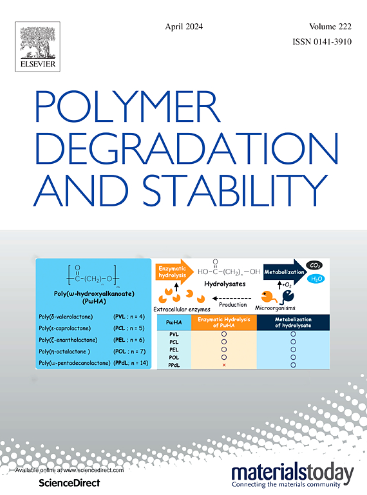Understanding degradation mechanism for long-term natural weathering of building silicone sealant to guide future façade design, inspection, and accelerated testing methods
IF 6.3
2区 化学
Q1 POLYMER SCIENCE
引用次数: 0
Abstract
Silicone sealants play a central role in the structural integrity and sealing performance of modern building façades. Yet, due to its relatively recent implementation in construction, little is known about its long-term degradation behavior in building contexts. Herein, we analyzed the degradation mechanisms of silicone sealants exposed to more than three decades of natural weathering in a high-rise tower façade. Our findings revealed that acid rain is the most detrimental factor to the silicone material – leading to the dissolution of the filler particles and inducing hole defects and microscale cracking. At a slower rate, the weathering exposure also led to the deterioration of the silicon-carbon atomic structure. The observed degradation led to a marked decrease in elongation capacity and an increase in the modulus of elasticity of the material. Nonetheless, the visual appearance and mechanical properties of the weathered sample still conformed with performance standards – reiterating the excellent durability of silicone in building assets. Overall, the obtained knowledge serves as a reference for future weathering studies on silicone and similar elastomeric materials as well as guide future façade design and inspection guidelines.
了解建筑硅酮密封胶长期自然风化的降解机理,指导未来建筑硅酮密封胶的设计、检验和加速测试方法
硅酮密封胶在现代建筑立面的结构完整性和密封性能中起着核心作用。然而,由于其在建筑中的应用相对较新,人们对其在建筑环境中的长期降解行为知之甚少。在此,我们分析了硅酮密封胶暴露在一个高层塔楼表面超过三十年的自然风化的降解机制。研究结果表明,酸雨是有机硅材料最有害的因素,酸雨会导致填料颗粒溶解,产生孔洞缺陷和微尺度开裂。在较慢的速度下,风化暴露也导致了硅碳原子结构的恶化。观察到的退化导致材料的伸长率显著下降和弹性模量增加。尽管如此,风化样品的视觉外观和机械性能仍然符合性能标准,重申了有机硅在建筑资产中的优异耐用性。总的来说,所获得的知识为未来有机硅和类似弹性体材料的风化研究提供了参考,并指导了未来的外观设计和检测指南。
本文章由计算机程序翻译,如有差异,请以英文原文为准。
求助全文
约1分钟内获得全文
求助全文
来源期刊

Polymer Degradation and Stability
化学-高分子科学
CiteScore
10.10
自引率
10.20%
发文量
325
审稿时长
23 days
期刊介绍:
Polymer Degradation and Stability deals with the degradation reactions and their control which are a major preoccupation of practitioners of the many and diverse aspects of modern polymer technology.
Deteriorative reactions occur during processing, when polymers are subjected to heat, oxygen and mechanical stress, and during the useful life of the materials when oxygen and sunlight are the most important degradative agencies. In more specialised applications, degradation may be induced by high energy radiation, ozone, atmospheric pollutants, mechanical stress, biological action, hydrolysis and many other influences. The mechanisms of these reactions and stabilisation processes must be understood if the technology and application of polymers are to continue to advance. The reporting of investigations of this kind is therefore a major function of this journal.
However there are also new developments in polymer technology in which degradation processes find positive applications. For example, photodegradable plastics are now available, the recycling of polymeric products will become increasingly important, degradation and combustion studies are involved in the definition of the fire hazards which are associated with polymeric materials and the microelectronics industry is vitally dependent upon polymer degradation in the manufacture of its circuitry. Polymer properties may also be improved by processes like curing and grafting, the chemistry of which can be closely related to that which causes physical deterioration in other circumstances.
 求助内容:
求助内容: 应助结果提醒方式:
应助结果提醒方式:


